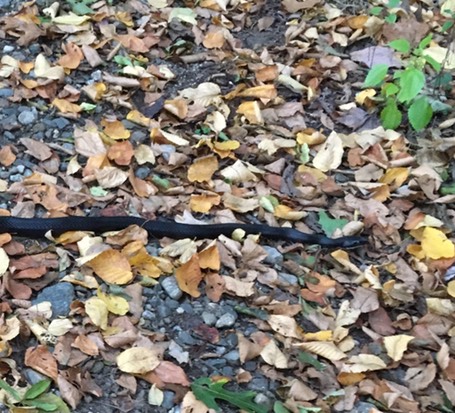As usual, crossposted from my live journal!
“You are not going back out to discover if Louise, magnificent though she be, likes cocoa. Save your experimental zeal for the morning.” (Kate Murry, to her young son Charles Wallace, quoted from memory from A Wind in the Door)
So I’ve been thinking of some beloved books, and real-world equivalents of their plants and animals. I’ll start with Madeleine L’Engle.
What sort of snake is Louise the Larger?

Well, what do we know about Louise?
She lives in a stone wall near an orchard in Northwestern Connecticut. She is fairly tame and friendly toward the young boys who name her. She is big, and black. She’s got a pretty strong grip, winding herself round the children’s arms and shoulders. Of course, there’s a lot more to Louise than that, as fans of A Wind in the Door will know. But those are the basic facts. She’s a black snake, and that’s what she gets called. As a young teen reading the book for the first time, I was convinced she was a black racer, because that was the only black snake I’d ever heard of.
So, when I spotted this lovely creature on a hiking path last fall, I naturally assumed she was a black racer. When I posted her pic to iNaturalist, that’s what I called her. And that’s when things got interesting.
I got in a conversation with some people who were more knowledgeable than I. They convinced me that my Louise—and, most likely, Madeleine L’Engle’s—was a black rat snake. They pointed to things like the amount of white on her chin, the shape of her eyes—features that I wouldn’t even have noticed, nor known what to make of. I’m sure they’re right.
There are two “black snakes” in Southern New England—the Northern racer, and the black rat snake (also called the Eastern rat snake). Louise is large, as was the snake we photographed above, and the black rat snake is the largest snake in our area, growing up to 6 feet (near 2 meters) long. The back rat snake is also a little heavier-bodied than the racer. Both snakes can climb, but the black rat snake is perhaps a better climber. It’s a constrictor, which fits Louise’s firm grip. Finally, it’s often found near rock ledges, woods, and small fields, which also fits.
So, although we can’t be sure, I think Louise the larger, like the snake I saw, is probably a black rat snake. What do you think?
